by Winding Pathways | Apr 10, 2025 | Amphibians/Reptiles, Nature
Reading a new turtle book stirred memories of Rich’s boyhood near Cedar Lake in New Jersey.
The book, The Natural History of the Turtles of Iowa, by Terry Vandewalle and Neil P. Bernstein is Iowa focused but applies to turtles over a great swath of North America.
Poking Around Cedar Lake
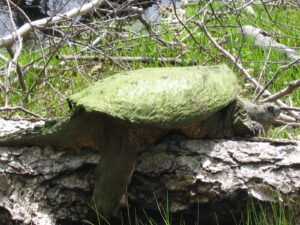
Snappers have powerful jaws.
During his adolescent and high school years Rich spent hours in, on, or around the 99-acre lake. “I remember rowing through a weedy area and pausing to watch a musk turtle walk along the muddy bottom. I’d often see painted turtles, which I called painters, basking in the sun. Every once in a while, the triangular head of a giant snapper would pierce the surface. Then, there were Eastern box turtles and wood turtles that I’d spot while walking,” he recalled.
Although Cedar Lake is a thousand miles east of Iowa, according to the authors our state has musks, snappers, painters, and box and wood turtles, although the last is the Ornate Box Turtle, a Midwestern species.
Turtles of Iowa book
Reading through the new book brought more than pleasant memories. It provided accurate, current information on the natural history of all of Iowa’s wild turtles. It also created sadness at the plight of these amazing and beautiful reptiles.
The book has two general sections. The second and largest is a description of each species found in our state. It’s packed with natural history information and photos of adults, juveniles, and even turtle eggs and nests.
Decline of Turtle Habitat
The first section can leave a reader depressed. Turtles have a hard time living amid the massive habitat changes and direct exploitation caused by people. Although these changes also take place across the continent Iowa, perhaps, is an extreme example.
Turtles that thrive in prairies and wetlands saw their world contract by close to 100% through conversion to row crops, cities, and roads. No habitat, no turtles. They hang on in pockets of appropriate habitat. Perhaps more alarming is the theft of these noble reptiles by people for pets and the turtle meat market. On top of that, many are squashed by cars as they try to cross roads.
No Kidnapping Allowed!
AToo many people can’t seem to resist picking up a box turtle and taking it home. Kidnapping any species, especially turtles, is bad. Caring for a captured turtle is tricky and often results in its death. If it is released away from its home, the animal’s amazing homing ability stimulates a quest to walk home…….and face death on every road it crosses. Some turtles are caught and sold as pets. Others are sold for their meat. Collection is adding population stress to animals suffering habitat loss. Don’t do this! Enjoy them from a distance and let them go on their way.
-
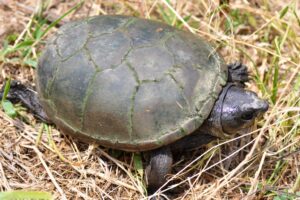
-
Yellow Mud Turtle in grasses.
-
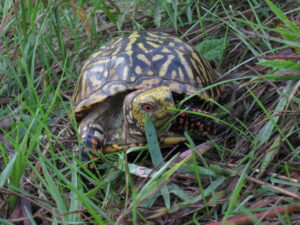
Iowa’s Turtles
Vandewalle and Bernstein graphically describe the plight of today’s turtles while offering hints of optimism. For example, the Iowa Department of Transportation crafted a tunnel under the new Highway 100 near Cedar Rapids. It’s become a safe way for Blandings and other turtles to cross under the busy road.
This book is a good read. This Bur Oak guide is published by the University of Iowa Press. For information or to order it visit University of Iowa Press. It can also be purchased from Amazon.
by Winding Pathways | Mar 27, 2025 | (Sub)Urban Homesteading, Home Improvements
- Disclaimer: Both Milwaukee and Ego have provided us with tools to test, however, we purchased most of our tools at retail cost, including Milwaukee and Ego brands.
There it was, printed clearly in the owner’s manual. Clean the tool.

Review the owners manual before operating a tool.
I’d just bought a Milwaukee Brand Random Orbit Sander. Even before handling it I fished the owner’s manual out of the box, wrote the date of purchase and location I bought it on the manual, and leafed through it. Included were clear instructions on the importance of cleaning the backing pad.
Test and Clean

Wood dust on bottom of sander.
After testing my new sander, I unfastened the backing pad to find a surprising amount of wood dust packed in crevices. A bit of work with a brush and rag, combined with brisk blowing, swept the debris away, making the sander ready for its next use.
“It’s important to keep all tools clean, lubricated and well maintained. Saws, grinders, and sanders tend to create much debris that can lodge inside them, said Pete Carlson, my tool mentor and and an employee of Milwaukee Tools. “Keeping them clean helps the tool run efficiently, and safely,” he added.
Habit
I think I’m unusual. Right after buying any mechanical device, whether it is a new refrigerator, fishing reel, or tool, I write the date of acquisition on the owner’s manual and include where I bought it. Then I leaf through the instructions and place them in a permanent file for future reference. I also use a Sharpie pen and write my name and the purchase date on the new item. Above all, I immediately clean the tool when done using it.
Read the Manual
Reading the manual helps me learn the capabilities of a tool or reel that I didn’t know. Instructions also clearly detail maintenance needs and sometimes include troubleshooting and repair information if there’s a problem.
At Winding Pathways, we use chainsaws, trimmers, mowers, and snowblowers for outdoor land management and a diversity of carpentry tools for home maintenance. Years ago, I bought a starter kit of battery-powered Milwaukee brand tools and have built on the system often. I love ‘em for their efficiency, ease of use, and safety.
Lesson from the Army
Back in Army trainee days my squad’s crusty drill sergeant wouldn’t let us go to chow after a tiring day until we’d thoroughly cleaned our rifles. We were usually starved but knew the sergeant was right. It became a habit. Now, after a chainsaw session I may be tired and hungry but the priority is cleaning and sharpening the saw.
Clean the tool.
Rich’s Tool Tips
- Buy quality tools, but before using one read the owner’s manual.
- Wear protective gear. Usually, that means hearing and eye protection, sturdy gloves and shoes, and, when chainsawing chaps.
- Clean every tool after use.
- Keep cutting tools sharp, lubricated, and well-maintained.
Respecting Tools
Tools are amazing. They make the most difficult chore easier and faster. But they should be treated with care and respect and used safely.
Sourcing Tools

Side view with date of purchase.
Most of our tools are either the Milwaukee or EGO Brand. We like them both and occasionally buy a new tool to run on their battery systems. As we buy new tools or replace old ones, we tend to buy Milwaukee for the quality and convenience of using one battery system. Other companies sell quality tools as well.

The snowblower starts with a push of a button.
by Winding Pathways | Mar 20, 2025 | Chickens
We have a DEI Chicken Flock. Diversity, Equity, and Inclusion in chickens??? Yes! A smart way to husband animals. And honor people, too.
DEI Variety
Within our small flock are chicken breeds with various body types, feather colors, origins, and dispositions. Here’s what we have:
- Light Brahmas are huge with a quiet personality and mostly white feathers. Their distant ancestry may be traced back to Asia, so they’re named after the Brahmaputra River.
- New Hampshire Reds are medium-sized hard-working brown egg layers with light reddish feathers. They’re Yankees to the core. Industrious. Taciturn. Weather tough.
- Delawares are another medium-sized brown-egg layer with mostly white feathers and a name honoring our second smallest state.
- Mystic Onyxes, bred by Hoover’s Hatchery, are jet black and socially reserved.
- Buff Cochins are huge birds with fluffy-buffy feathers. Only modest brown egg layers but friendly. Cochin is a region in Southern Vietnam.
- California Whites are nervous fast-moving white-egg layers always on the lookout for predators…..and they’ll let the flock know when they see one. It’s named for our most populous state.
-
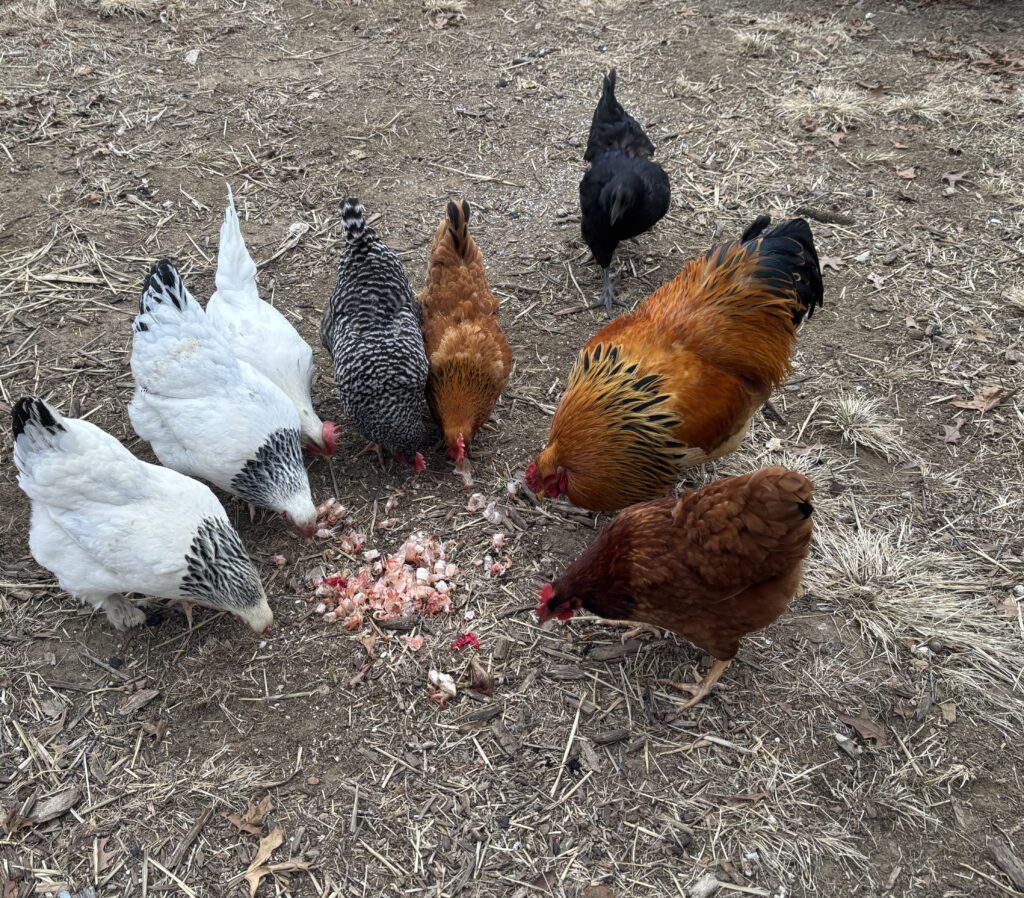
-
Gathering around
-
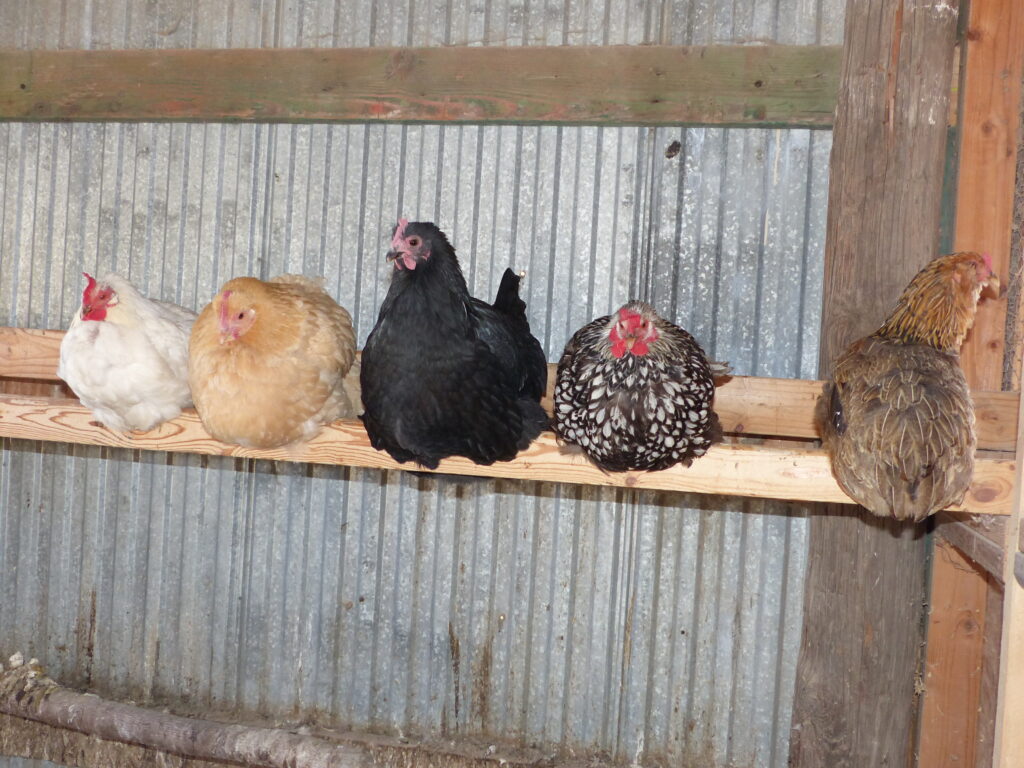
-
Roosting comfortably
-
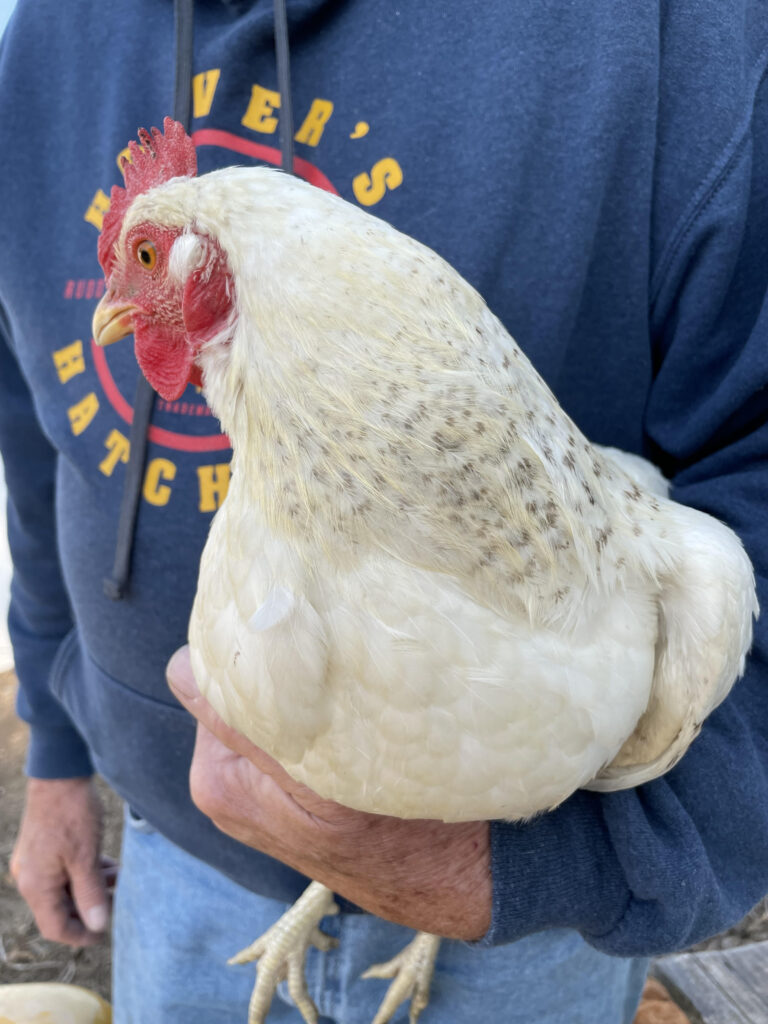
-
Delawares are elegant hens.
Blending Characteristics
Our DEI chicken flock of mixed breeds includes a blend of good characteristics. Together they create a community of diversity and strength. Occasionally they have a kerfuffle. Don’t we all? Mostly they get along with each other and help each other out. Partly because we give them space and good living quarters, and treat them kindly. It’s a resilient, mutually supportive, and productive flock. We treat them all equally and humanely. In return they eat food scraps (no waste into the sewer system or landfill), give us their jewel eggs, and entertainment as we chuckle at their antics.
-
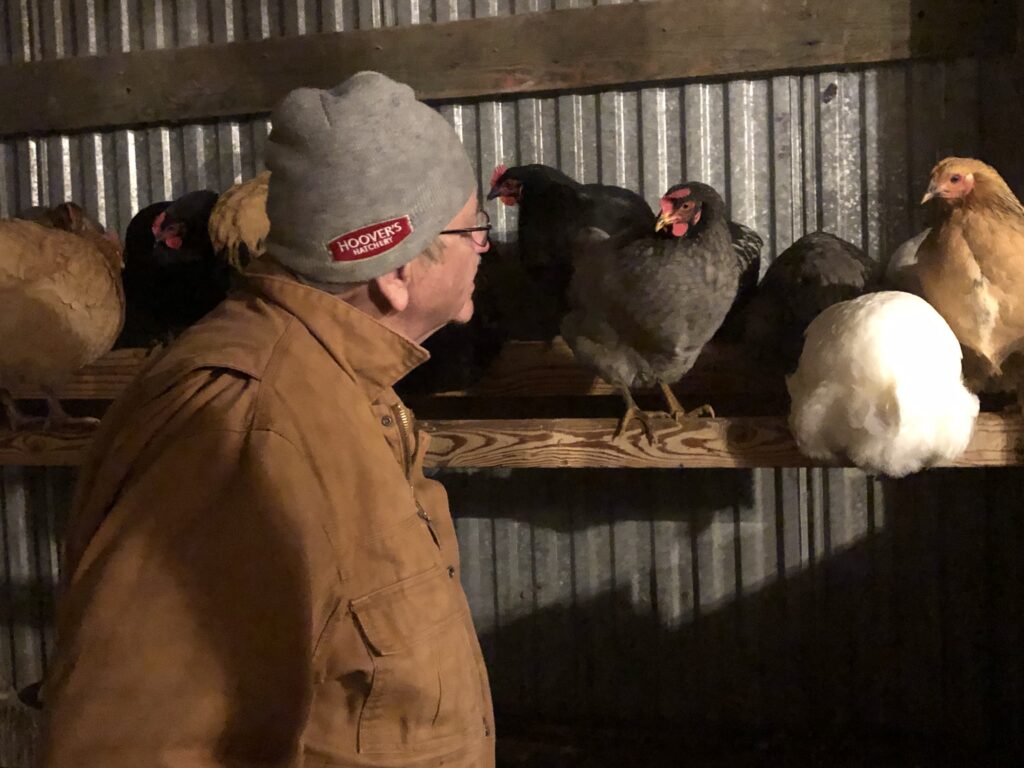
-
Cozy roosting on cold winter night.
-
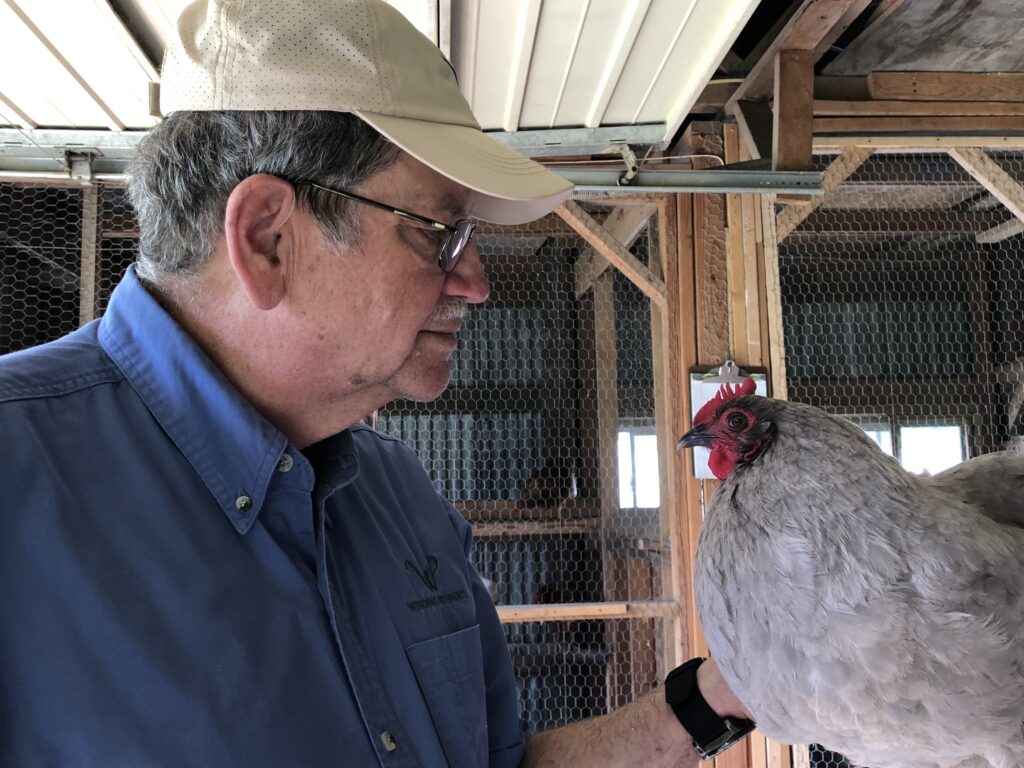
-
People can learn a lot by chatting with chickens.
-
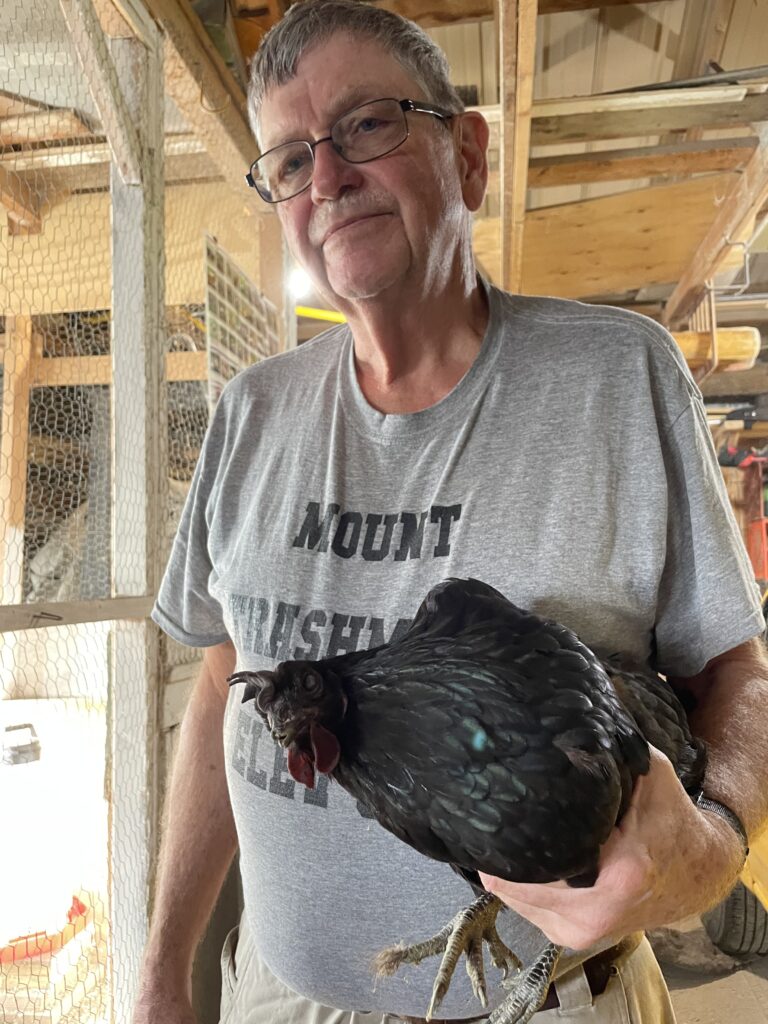
-
Iridescence of feathers.
-
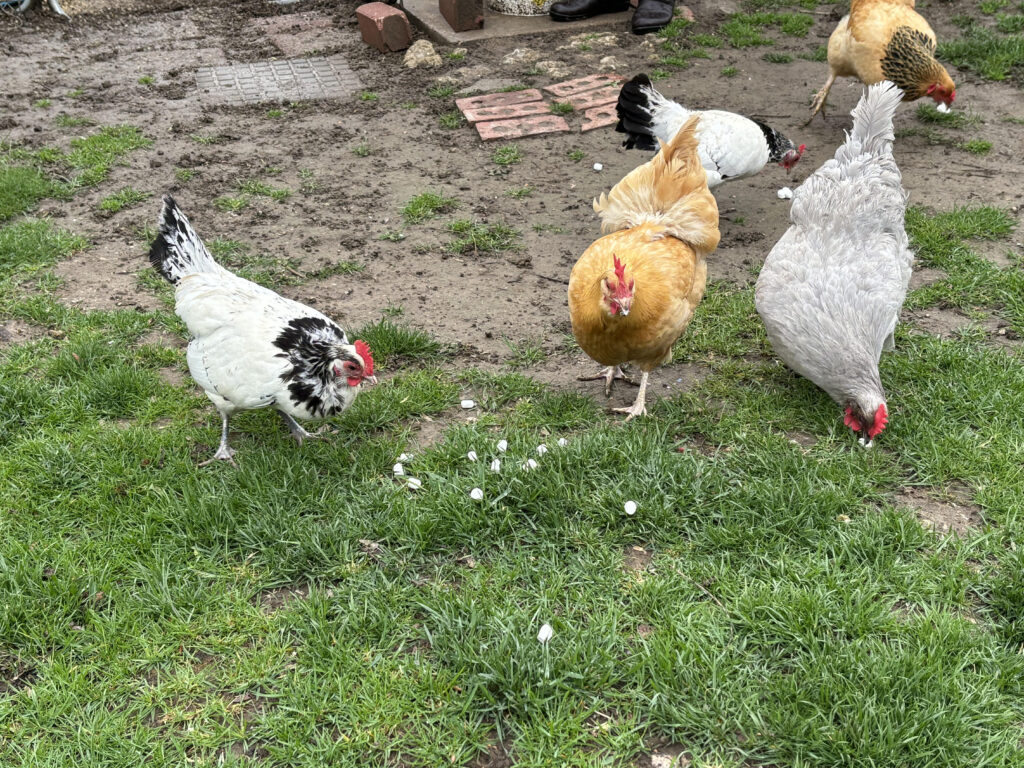
-
Chickens love treats!
-
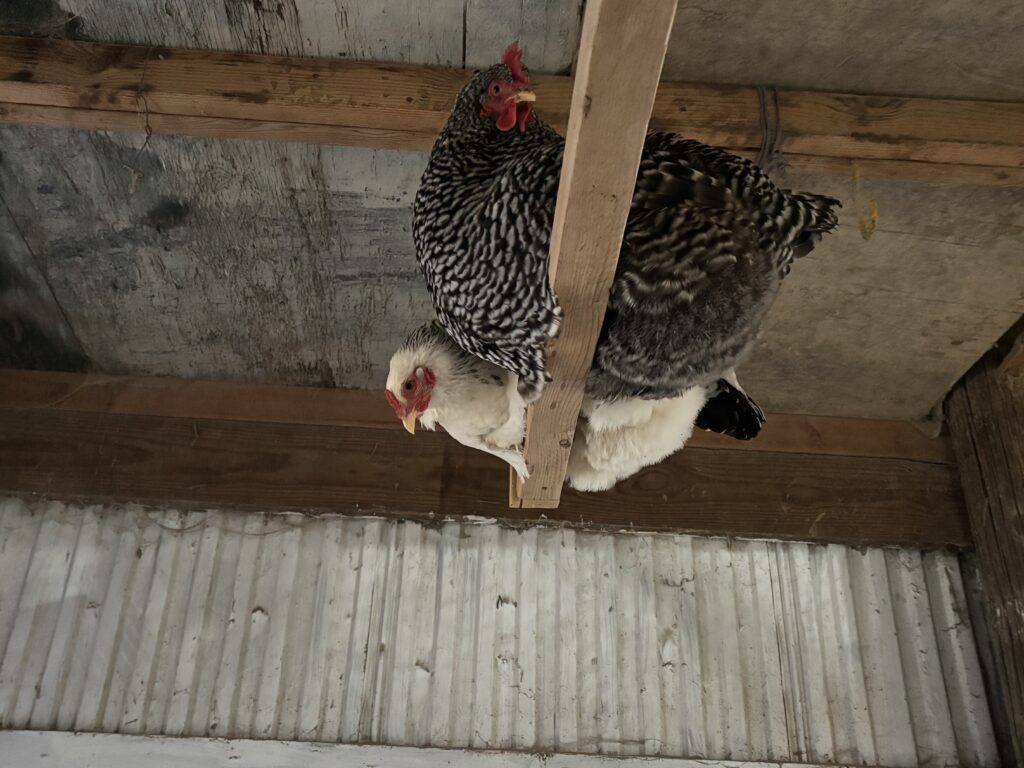
-
Chickens roost up high.
-
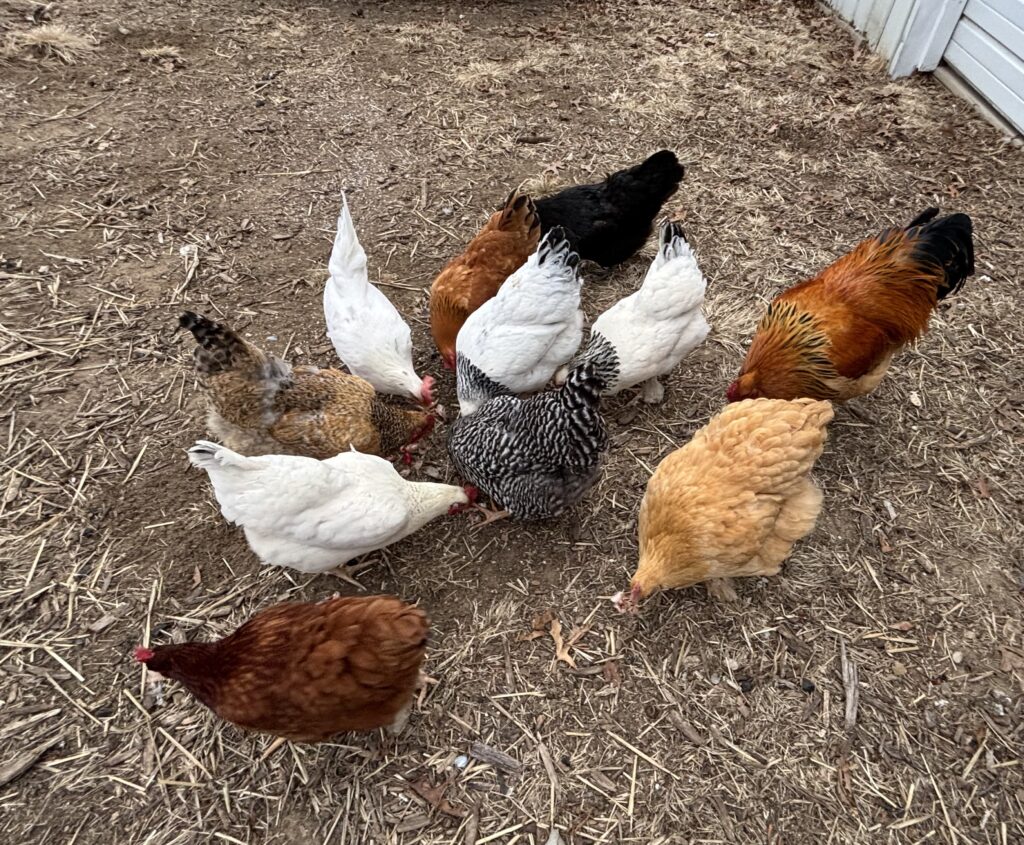
-
Note the colors & sizes.
Lessons
We have had chickens for decades. Even as young kids. Our chickens always teach us about personality diversity. Each chicken breed has likely common characteristics. Then, there’s personality variation within a breed. For example, we collect eggs by lifting the lid of each nest. Sometimes there’s a hen occupying it. If it’s a Black Onyx we get thoroughly scolded by her for disturbing her privacy. However, if a Light Brahma is in the nest she doesn’t seem to mind at all being spied on.
Our flock is also healthier because we DO provide space and superior nutrition, keep the coop and run clean, and remove opportunities for pests like mice and House (English) Sparrows to bring in diseases or eat valuable feed.
The same holds true for people. When we treat each other well, build on our strengths, and have open minds, everyone is better off.
As a nation, like in DEI chicken flocks, we are stronger, wiser, and healthier in diversity, equity, and inclusion.
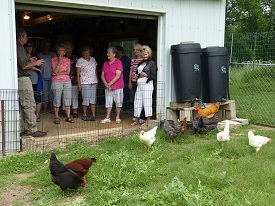
While chickens forage Rich shares about our projects.
by Winding Pathways | Mar 13, 2025 | (Sub)Urban Homesteading, Chickens, Garden/Yard
Soaring Prices Cause People to Question
Does keeping a backyard flock make sense?
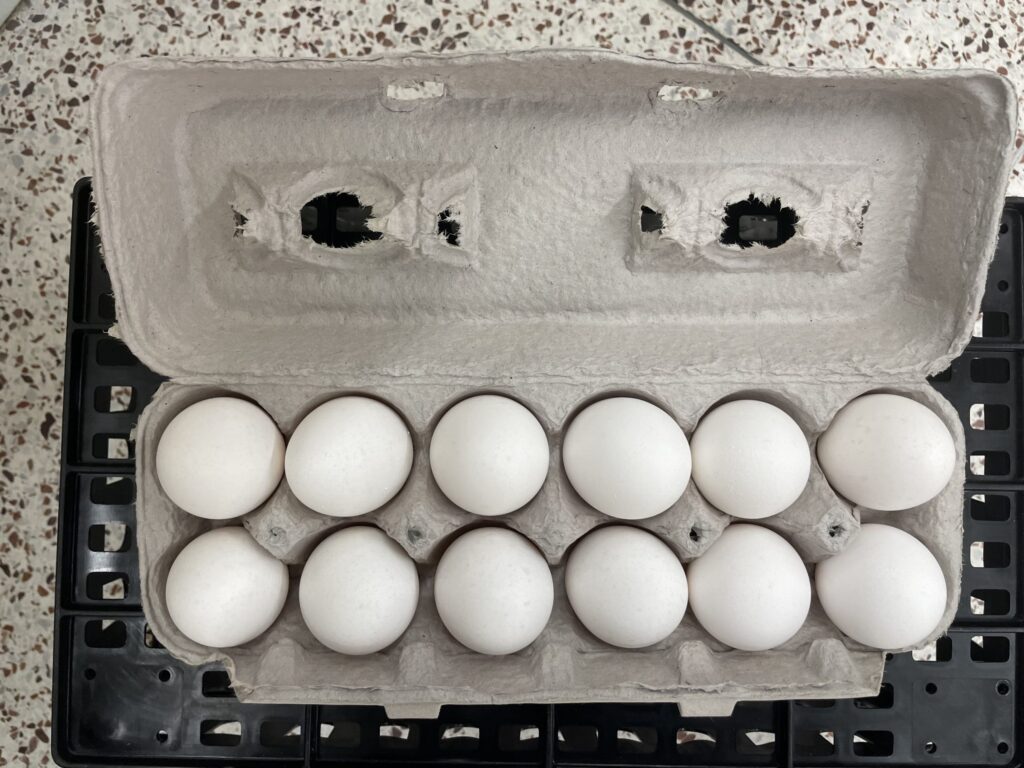
Store eggs come from one breed of chickens.
While shopping at a nearby grocery store, we noticed eggs for sale at $6 with a purchase limit of two dozen. After returning home, we visited our backyard coop and collected eight eggs, which is a fairly typical daily production from our ten hens.
With egg prices soaring and availability uncertain, many people are considering building a coop, buying chicks, and producing eggs in the backyard.
Consider Carefully
Does a backyard flock make sense, or is investing in one a way to save money? Is it a good idea to keep chickens?
It depends. Ask first, what is your lifestyle? Do you like working around a yard and tending animals? Will you keep the coop and run clean? How much space do you have for a small flock? What other animals do you have? How often do you travel? What is your relationship with neighbors? Is keeping a small flock legal in your community?
Then, do your research.
We’ve tended small backyard flocks for nearly 50 years and have much experience managing chickens. Fortunately, many towns and cities changed their ordinances to allow suburban and urban flocks and thousands of families have begun keeping chickens. For those willing to do the daily work, they are well suited for suburbia.
Will A Backyard Flock Reduce the Grocery Bill?
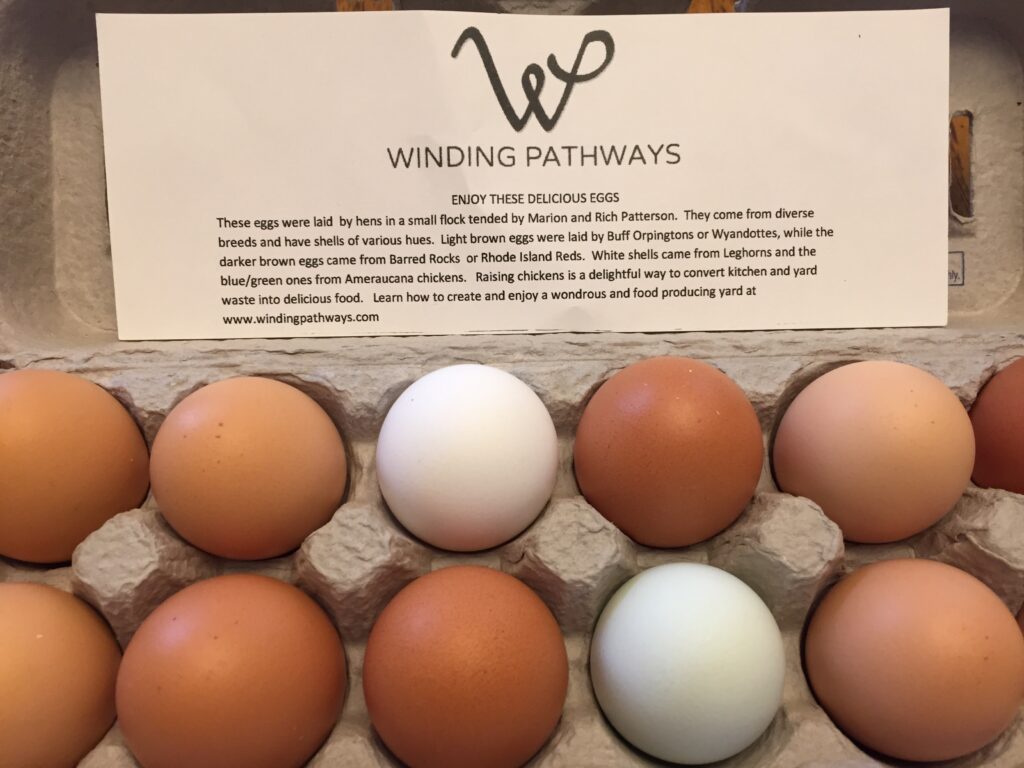
Beautiful eggs
For many families chickens are a rewarding hobby with a side benefit of delicious food and garden fertilizer. But, do those hens produce eggs at a lower price than at the grocery?
Maybe.
What is Economy of Scale?
Huge commercial egg producing farms house millions of layers of genetic strains developed for maximum egg production. They buy feed at huge discounts.
Their economy of scale has, until recently, enabled grocery stores to sell eggs at amazingly low prices.
In contrast, there’s no economy of scale in caring for a small flock. Stores offer no discounts when buying a bag or two of layer feed. It costs us about $5 a dozen to produce eggs from our ten-hen flock. So, at today’s prices we’re probably saving a little money, but during normal times our backyard eggs are more expensive than store bought ones.
More Than Money
That’s only part of the picture. We can count on our hens to lay eggs every day. Recently our grocery store was out of eggs. Reliability is a benefit and there’s more.
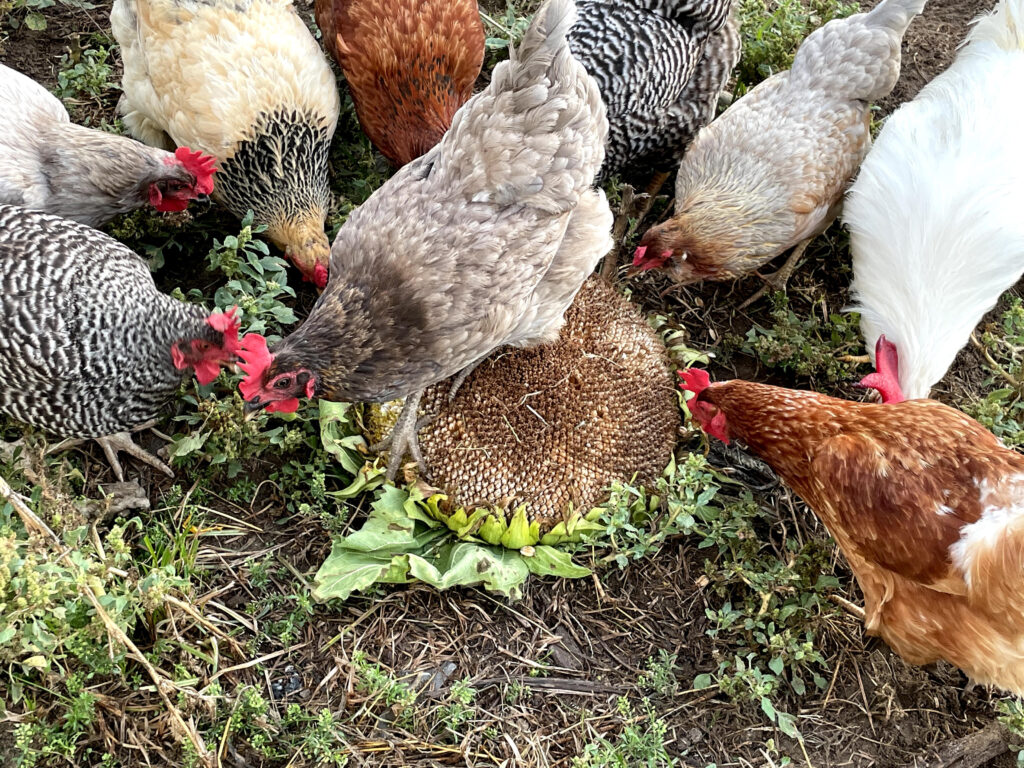
Chicken enjoy varied diet
We take pride in producing as much of our food in our yard as possible. Both garden vegetables and backyard eggs are absolutely fresh, delicious, and reliable. And, we know our chickens are raised humanely. We like them. They are fun. Our chickens give us a laugh with their comic peculiarities. They are beautiful. They talk to each other and clearly communicate, recognize us and eagerly anticipate the treats we give them daily.
Our End Benefit
For us producing food is a satisfying activity that gives us both peace of mind and pleasure.
Should A Family Tend a Backyard Flock?
Caring for any living creature entails responsibility. Chickens, like a family dog or cat, need daily care that can be time-consuming. If a family enjoys animals and is willing to devote time and energy to their daily care, a backyard chicken flock may fit perfectly into their lifestyle and yield eggs. Caring for chickens can be an enjoyable family project, an educational adventure for children with fresh eggs as a bonus.
However, if a family sees a flock solely to save money at the grocery and doesn’t enjoy daily animal care, establishing a flock is a mistake.
There’s a lot to learn when establishing a chicken hobby. Excellent information is available on our own website Winding Pathways or the Hoover’s Hatchery website. Many physical books and online sources also help with learning.
Final thought: Remember, make it fun!
by Winding Pathways | Mar 6, 2025 | Chickens, Garden/Yard
What is a Marshmallow Scramble?*
- It’s an easy, entertaining way to get chicks to come home for the night.
Every afternoon, with great enthusiasm, our chickens do the marshmallow scramble. Until recently we didn’t know chickens love the sugary balls of puff, but neighbor, Joann Hoffman, a chicken aficionado demonstrated with her small flock. As her small flock of hens gathered around her in anticipation, she tossed out a few mini marshmallows. The tiny treats vanished in a flash!
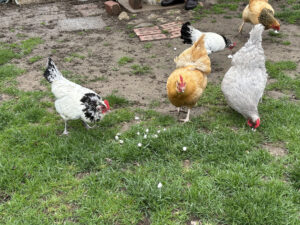
Chickens love treats!
We bought a few bags of baby marshmallows on our next foray at the grocery store. That afternoon we tossed a handful to our chickens. Cocking their heads, they eyed them with suspicion. Stepping close, cocking their heads another way, stepping away with disdain, then stepping back in as curiosity overcame their caution. One finally sampled the strange tidbit. Then, scrambled for more. Other chickens scrambled for a taste of this exotic, new “food.”
Understand, please that the marshmallow scramble is a special treat. We make sure the hens and rooster have plenty of nutritious foods and treats especially in the winter.
Now, marshmallow time happens every afternoon when we want to lure the hens into the coop for the night. They’ve even learned the phrase, “marshmallow time.” When we shout those words the flock scurries into the coop. We toss in marshmallows and enjoy watching the wild marshmallow scramble. While they’re busy snapping them up we close the pop hole door, securing the coop from nocturnal predators.
Take a look at this mad chicken marshmallow scramble.
While putting the blog together we even learned some about the history of marshmallows. Kind of interesting.





















